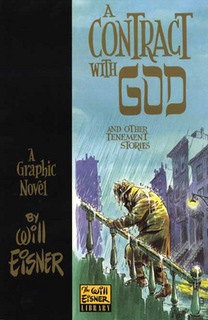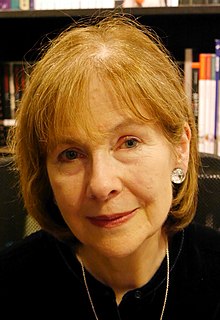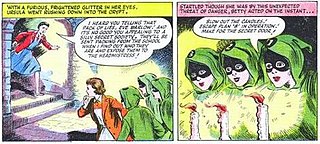Related Research Articles

Jack Ralph Cole was an American cartoonist best known for creating the comedic superhero Plastic Man, and his cartoons for Playboy magazine.

A graphic novel is a book made up of comics content. Although the word "novel" normally refers to long fictional works, the term "graphic novel" is applied broadly and includes fiction, non-fiction, and anthologized work. It is, at least in the United States, distinguished from the term "comic book", which is generally used for comics periodicals.

Comics is a medium used to express ideas with images, often combined with text or other visual information. It typically takes the form of a sequence of panels of images. Textual devices such as speech balloons, captions, and onomatopoeia can indicate dialogue, narration, sound effects, or other information. The size and arrangement of panels contribute to narrative pacing. Cartooning and other forms of illustration are the most common image-making means in comics; fumetti is a form that uses photographic images. Common forms include comic strips, editorial and gag cartoons, and comic books. Since the late 20th century, bound volumes such as graphic novels, comic albums, and tankōbon have become increasingly common, while online webcomics have proliferated in the 21st century.

Patrick McDonnell is a cartoonist, author, and playwright. He is the creator of the daily comic strip Mutts, syndicated since 1994. Prior to creating Mutts, he began a career as a prolific magazine illustrator, and would frequently include a dog in the backgrounds of his drawings.

Franklin Christenson "Chris" Ware is an American cartoonist known for his Acme Novelty Library series and the graphic novels Jimmy Corrigan, the Smartest Kid on Earth (2000), Building Stories (2012) and Rusty Brown (2019). His works explore themes of social isolation, emotional torment and depression. He tends to use a vivid color palette and realistic, meticulous detail. His lettering and images are often elaborate and sometimes evoke the ragtime era or another early 20th-century American design style.
Plug was a British comic magazine that ran for 75 issues from 24 September 1977 until 24 February 1979, when it merged with The Beezer. It was edited by Ian Gray.

Rosemary Elizabeth "Posy" Simmonds MBE is a British newspaper cartoonist, and writer and illustrator of both children's books and graphic novels. She is best known for her long association with The Guardian, for which she has drawn the series Gemma Bovery (2000) and Tamara Drewe (2005–06), both later published as books. Her style gently satirises the English middle classes and in particular those of a literary bent. Both of the published books feature a "doomed heroine", much in the style of the eighteenth- and nineteenth-century gothic romantic novel, to which they often allude, but with an ironic, modernist slant.

Paul Gravett is a London-based journalist, curator, writer and broadcaster who has worked in comics publishing since 1981.

Escape magazine was a British comic strip magazine founded and edited by Paul Gravett and Peter Stanbury. Nineteen issues were published between 1983 and 1989. Eddie Campbell, Phil Elliott and Glenn Dakin were amongst the many cartoonists published within its pages.
British small press comics, once known as stripzines, are comic books self-published by amateur cartoonists and comic book creators, usually in short print runs, in the UK. They're comparable to similar movements internationally, such as American minicomics and Japanese doujinshi. A "small press comic" is essentially a zine composed predominantly of comic strips. The term emerged in the early 1980s to distinguish them from zines about comics. Notable artists who have had their start in British small press comics include Eddie Campbell, Paul Grist, Rian Hughes, Jamie Hewlett, Alan Martin, Philip Bond and Andi Watson.

Patoruzú is a comic character created in 1928 by Dante Quinterno and is considered the most popular hero of Argentine comics. Patoruzú is a wealthy Tehuelche cacique with great estate properties in Patagonia, and possesses both superhuman physical strength and a charitable yet naive heart. He was originally only a side character in Quinterno's series "Don Gil Contento", but became so popular with readers that the comic was renamed after him.
Sky Masters of the Space Force was an American syndicated newspaper comic strip created on September 8, 1958 by writer Dave Wood and penciler Jack Kirby, featuring the adventures of an American astronaut.
René Ríos Boettiger, also known as Pepo, was a Chilean cartoonist, creator of the famous character Condorito.
Woodrow Phoenix is a British comics artist, writer, editorial illustrator, graphic designer, font designer and author of children's books.

Crime comics is a genre of American comic books and format of crime fiction. The genre was originally popular in the late 1940s and early 1950s and is marked by a moralistic editorial tone and graphic depictions of violence and criminal activity. Crime comics began in 1942 with the publication of Crime Does Not Pay published by Lev Gleason Publications and edited by Charles Biro. As sales for superhero comic books declined in the years after World War II, other publishers began to emulate the popular format, content and subject matter of Crime Does Not Pay, leading to a deluge of crime-themed comics. Crime and horror comics, especially those published by EC Comics, came under official scrutiny in the late 1940s and early 1950s, leading to legislation in Canada and Great Britain, the creation in the United States of the Comics Magazine Association of America and the imposition of the Comics Code Authority in 1954. This code placed limits on the degree and kind of criminal activity that could be depicted in American comic books, effectively sounding the death knell for crime comics and their adult themes.
Michael Gallagher is an American writer who has contributed to several comic books, as well as to the satire magazine Mad, to which he has contributed several two-page gags since the mid-1990s. He is the son of cartoonist John Gallagher, as well as the nephew of George Gately, creator of the comic strip Heathcliff. Besides Mad, Gallagher has contributed to Sonic the Hedgehog, as well as a comic book series based on the TV show ALF, and several works for both Marvel Comics and Archie Comics. Gallagher commented on his three-year run on Guardians of the Galaxy: "It was very cool to have the 'past' Marvel Universe to play with in such a unique way and bend it to my will, and Kevin [West]'s pencils were to die for. But the characters you inherit arrive with personalities, powers, and quirks which must continue. And in this case, several vital subplots and storylines were still in progress."
Wilson the Wonder Athlete was a British comic strip, first published in 1943 in the British illustrated story paper The Wizard published by D. C. Thomson & Co.. It follows the sporting adventures of a heroic character named William Wilson. The stories were written by Gilbert Lawford Dalton and drawn by Jack Glass. The stories ran until 1984 in various British magazines.

The Silent Three was a British comic strip published in the girls' comics magazine School Friend from 1950 to 1963, written by Horace Boyten and Stewart Pride, and originally illustrated by Evelyn Flinders. Three schoolgirls at St. Kit's boarding school, Betty Roland, Joan Derwent and Peggy West, banded together as a secret society against the tyranny of the head prefect, later also fighting crime wearing numbered masks and hooded green robes. In 1977 Posy Simmonds drew a weekly strip for The Guardian entitled The Silent Three of St Botolph's in tribute.
Tiffany Jones was a British comic strip that ran in syndication between 1964 and 1977 and was published in Daily Sketch. The series centred on a young woman who travelled to London to become a fashion model. It is notable for being created by two female comic strip artists, Pat Tourret and Jenny Butterworth. The strip portrayed feminist themes and included some erotic fanservice.

Živojin "Žika" Tamburić is a Serbian comics critic, historian, editor and publisher, most notable for his work on first critical comics lexicon in Eastern Europe, The Comics We Loved, Selection of 20th Century Comics and Creators from the Region of Former Yugoslavia (2011).
References
- ↑ Gravett, Paul, "1001 Comics You Must Read Before You Die", Universe, 2012, page 438.
- ↑ Gravett, Paul, "1001 Comics You Must Read Before You Die", Universe, 2012, page 438.
- ↑ Biff website
- ↑ Gravett, Paul, "1001 Comics You Must Read Before You Die", Universe, 2012, page 438.
- ↑ Guardian retrospective, accessed 26 April 2008
- 1 2 3 Press Release for 2007 retrospective, , accessed 26 April 2008